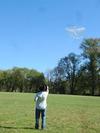One Dowel Rokkaku With a Side of Thermals!
by MBK Flight Reporter: Craig Ensey
(Shedd, OR, USA)

Cool Rok pic right before it crashed into the park on Sunday.
Since I was not able to get a good long flight with my MBK Rokkaku, I figured I would do a report with 2 flights adding up to more than 10 minutes worth of flight time. Although they were short lived, both flights had some great pics, and some exciting moments.
My original goal was to get back to the spirit of MBK kiting so to speak. To be honest, I've been frustrated as of late, almost to the point of hanging up my reel for a while when it comes to short flights and broken spars. Sometimes I get too complex too quickly, other times I can get anxious to fly my new creation. This often ends in a broken spar or three. Good thing I have some epoxy and string to get some spars spliced together.
As I thumbed through my stack of kite books from the local library, it occurred to me that I should build an MBK Eddy kite with as little modification as possible. In doing this I chose to build the MBK Rokkaku as an alternative to the Eddy.
The Rok seemed a better choice since it takes very little cost and effort but carries so much sail area when compared to the Eddy kite. Just like last time, I was a bit confused when it came to the spar size. Do I use 3/16" or 1/4"? That was the question of the evening. After remembering an E-conversation with Tim, I chose to use the 3/16" spars for my bows rather than 1/4". This was a light wind kite that shouldn't be flying in anything over six-ish mph.
Construction was quick and easy using the typical Dollar Tree drop cloths and poplar for spars. The only departure was using duct tape for spar pockets because that's what I had on hand. The total build time was about about 1 1/2 hours of easy building.
Out at the field, I had light winds with loads of thermal activity up high. It was a new field that I had never flown at, but it is big enough for a Rok. Setting the bridle was very easy, but the wind was shifting very badly in both speed and direction. This made it a bit more of a guessing game when I set the tow point for a good thermal hunting setting. One quick adjustment to the right had it flying pretty straight for my standards.
Up it went to 30 feet for a bit, but those variable winds kept giving me fits. It would have been easier if they were shifting 30 degrees, but I was dealing with 120+ degree shifts as well as some pretty strong gusts as the kite was struggling through the turbulence from the houses just upwind.
Once I found clear air, it was a bit smoother, but the wind shifts were really threatening the Rok's slender frame. Speaking of frames, I think the poplar is much weaker than the Tasmanian Oak I believe was used on the prototypes.
Of course, the wind died just as things were looking up... no pun intended. I had to bring it down and re adjust the tow-point for lower winds. After relaunching it the winds picked way up to 10+ mph - even more in the clear air up higher.
I was able to get some thermal action midway through the flight at 100 feet or so, but it floated over the top and got backwinded a few times. Unfortunately the backwinding caused the Rok to fall really low downwind where it was less than 30 feet up or 25 degrees of line angle. Not too much longer, it got caught in one of these cycles where it would fly up to vertical, backwind, and fall. As one would guess it lost the top spar. I guess I should carry a set of 1/4" spars in case of higher winds.
The second flight was a record short flight. It was at a local park that was surrounded by trees. It didn't seem windy enough down low, but it was a lot faster once I got up to about 30 feet or so. The kite had a bit of a lean to it that was unnoticeable in the light winds on Saturday, but it was a looping situation on Sunday. I guess it was more of an arc, but it plowed straight into the ground at high speed. The crash yielded a broken stem that cut the sail right up the middle.
Fortunately, I was able to get a record flight on my Tri-D box, but I will tell you about that later.
Return to MBK Flight Reporter Submission.
As mentioned earlier, there's more kite making on this site than you can poke a stick at. :-)
Want to know the most convenient way of using it all?
The Big MBK E-book Bundle is a collection of downloads—printable PDF files that provide step-by-step instructions for many kites large and small.
That's every kite in every MBK series.







